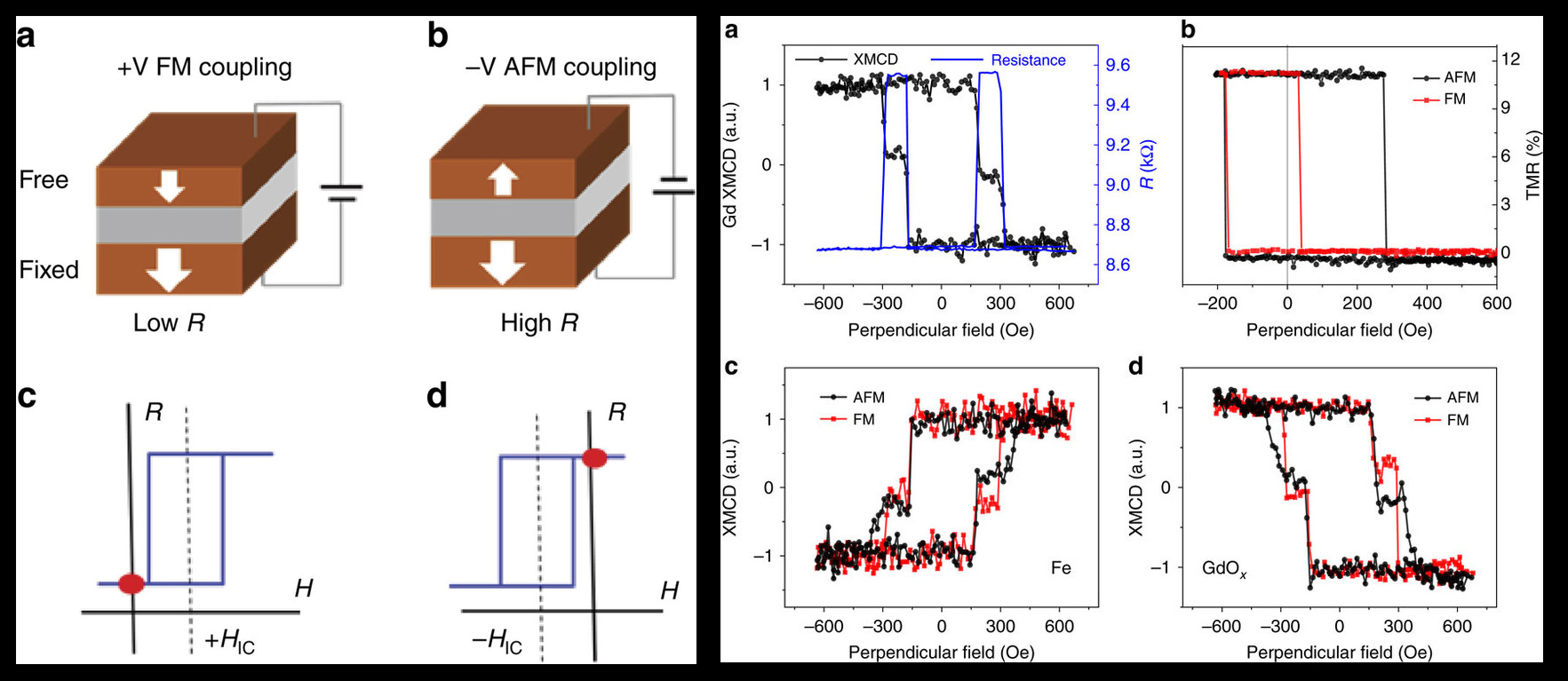A team of researchers using the U.S. Department of Energy’s Advanced Photon Source (APS) has demonstrated a way to use voltage to change the state of nano-magnets with perpendicular magnetization in a non-volatile and reversible method. This result paves the way for a new switching method by using voltage to change the coupling between two magnetic layers, and could lead to advances in data storage devices.
As transistors for information storage and processing applications become smaller and more densely packed one on top of the other, their power consumption and waste-heat dissipation present a limiting factor to performance. Much effort has been directed by the electronics industry toward developing lower-power transistors and logic devices that require less energy and thus generate less heat. A very promising technology is the magnetic tunnel junction (MTJ), which has the considerable advantage of non-volatility. Non-volatility simply means that an MTJ device needs no power to maintain its logic state, as opposed to traditional CMOS electronics, which must be constantly refreshed at the expense of high power consumption and output.
A magnetic tunnel junction is a thin-film multilayer stack consisting of an ultra-thin insulator (~1 nm) sandwiched by two ferromagnetic (FM) layers. Due to spin-polarized quantum mechanical tunneling, the resistance of a MTJ depends on the relative orientation of the magnetizations between the two ferromagnetic layers, exhibiting a low resistance value when the magnetizations are in the parallel configuration and a high resistance value when the magnetizations are in the antiparallel configuration resulting in AFM coupled states. This change in resistance can be very large, making MTJs a very attractive technology for logic and memory applications.
While MTJs are non-volatile, they are typically switched with a magnetic field or a spin-polarized current, which requires large amounts of energy. Therefore, to further reduce the energy consumption, a way to switch the layer magnetization with voltage alone is extremely attractive.
In this work, the preferred relative orientation of two cobalt-iron-boron magnetic films separated by a unique rare-earth oxide, GdOx, can be reversibly and deterministically changed from parallel to antiparallel with applied voltage. Using the X-ray Science Division x-ray beamline 4-ID-C at the APS, an Office of Science user facility at Argonne National Laboratory, the research team from The University of Arizona, Argonne, Oak Ridge National Laboratory, the University of Minnesota, and Bryn Mawr College investigated the mechanism of the voltage controlled coupling effect, finding an induced gadolinium moment that tracks the iron moment, revealing the role of oxygenation of the magnetic layers in the coupling. The coupling between the magnetic layers is changed when the electric fields modify the oxygenation states of the magnetic layers.
Although the time scale of the effect is in seconds or tens of seconds in this proof-of-concept study, it is expected that the speed of the voltage controlled interlayer coupling can be greatly increased with further optimization.
See: T. Newhouse-Illige1, Yaohua Liu2, M. Xu1, D. Reifsnyder Hickey3, A. Kundu1, H. Almasi1, Chong Bi1, X. Wang4, J.W. Freeland5, D.J. Keavney5, C.J. Sun5, Y.H. Xu1, M. Rosales1, X.M. Cheng4, Shufeng Zhang1, K.A. Mkhoyan3, and W.G. Wang1, “Voltage controlled interlayer coupling in perpendicularly magnetized magnetic tunnel junctions,” Nat. Commun, published online May 16, 2017. DOI: 10.1038/ncomms15232
Author affiliations: 1University of Arizona, 2Oak Ridge National Laboratory, 3University of Minnesota, 4Bryn Mawr College, 5Argonne National Laboratory
Correspondence: *wgwang@physics.arizona.edu
This work was supported in part by C-SPIN, one of six centres of STARnet; a Semiconductor Research Corporation programme, sponsored by MARCO and DARPA; and by the National Science Foundation through ECCS-1554011. Work at Oak Ridge National Laboratory was supported by the Division of Scientific User Facilities of Basic Energy Sciences, U.S. Department of Energy (DOE) Office of Science. Work at Bryn Mawr College is supported by National Science Foundation CAREER award (No. 1053854). This research used resources of the Advanced Photon Source, a U.S. DOE Office of Science User Facility operated for the DOE Office of Science by Argonne National Laboratory under Contract No. DE-AC02-06CH11357. We thank Dr. Richard Rosenberg and Mr. Yu Le for assistance during the synchrotron experiments. This research used resources of the Advanced Photon Source, a U.S. DOE Office of Science User Facility operated for the DOE Office of Science by Argonne National Laboratory under Contract No. DE-AC02-06CH11357.
Argonne National Laboratory seeks solutions to pressing national problems in science and technology. The nation's first national laboratory, Argonne conducts leading-edge basic and applied scientific research in virtually every scientific discipline. Argonne researchers work closely with researchers from hundreds of companies, universities, and federal, state and municipal agencies to help them solve their specific problems, advance America's scientific leadership and prepare the nation for a better future. With employees from more than 60 nations, Argonne is managed by UChicago Argonne, LLC for the U.S. Department of Energy's Office of Science.
The U.S. Department of Energy's Office of Science is the single largest supporter of basic research in the physical sciences in the United States and is working to address some of the most pressing challenges of our time. For more information, visit the Office of Science website.

